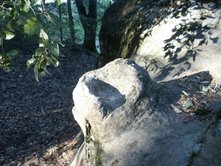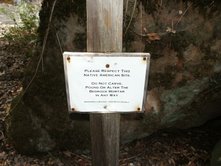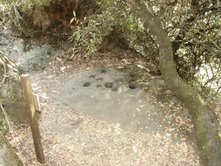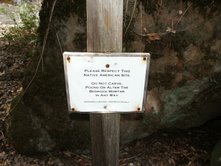Story by John Vonderlin (email John: [email protected])
Hi June,
The email I recently sent you about the rocks that were probably polished by the mud-soaked flanks of mammoths and bison rubbing against them, reminded me of another rump-rounded rock a lot closer to home that I stumbled on a few years ago.
I had recently bought my first digital camera, a high dollar “prosumer” Minolta model that was a “steal,” thanks to a clerk mis-marking a floor model being cleared out. Without any particular talent or much experience, but having a high-tech camera with an awesome lens, I embarked on a mission of photographing everything I could find of interest. I was working my way through the various open space preserves in San Mateo County, when I visited the Russian Ridge Open Space Preserve.
While wandering near Alpine Pond, photographing everything in sight, I stumbled upon a rock with grinding holes in it, made by the Ohlone Indians. There was nothing secret about this rock. It was visible from the path and a small sign requests respect for the Native American site, forbidding alterations of any sort.
Looking for a good shot (and feeling that I was helping to preserve, rather then alter anything), I cleaned out the holes, which were clogged with debris and took a few pictures. Later, I learned from a newspaper article about docent walks in the area, that this rock is called “Gossip Rock,” though I find no mention of it on the Internet.
Thinking that where there is one such special rock, there are usually more, so I scouted the nearby woods and photographed other rocks, also marked with grinding holes.
But, it was when I started checking out the huge boulder looming above Gossip Rock, just across the trail, that I made an intriguing series of discoveries. First, climbing up the hill on the west side of the boulder, I found, at waist level, a protuberance rising from the rock, topped by a chalice-shaped manmade feature. One edge of the “bowl” was missing but it appeared to have been so perfect at one time that I assumed it had to be manmade. Above it I noticed the rock was much smoother then the surrounding rock.
Fascinated, I clambered to the top where I found a hollow in the rock that was the size of a small bath tub. It was also filled with debris, but looked like it might have held a decent amount of water at some time, especially after I cleaned it out.
From the top of the rock, I could see Gossip Rock some 50 feet away. Looking down, I saw another smoothed, chute-like area that descended to the ground. I remember thinking this was either an Ohlone ceremonial site or their version of a children’s play area.
Knowing that the year ‘round, ridge-top springs, now submerged by the dammed Alpine Pond, must have made this a very attractive area, particular in the summer, I assumed this must have been a permanent settlement. High above the heat of the valley on one side, balanced by the damp coolness of the fog on the other, it must have been an idyllic place to prepare the winter’s larder of acorns.
It’s not surprising that in the 1930s California Governor James (Sunny Jim) Rolph christened a nearby beautiful knoll his “Summer Capital,” building a home adorned with a gold-painted, paper- mache dome.
My guess is the spacious pond, created when the dam was built, has submerged whatever Indian village or camp that was there.
A few months later, I attended a fascinating lecture in San Jose about the Ohlone Indians. I gave the photos of my find to the state parks scientist delivering the talk. He said he assumed the “offering bowl” was a concretion. Being a collector of concretions, and quite knowledgeable about them, I demurred.
Later, I contacted another state employee connected with Ohlone research. He said there was no tradition of rock carving by the Ohlone and identified the “bathtub” as an artifact of the acid in oak leaves that had, over time, eroded it.
Neither expert explained to me why these features existed on a rock near a Native American site, something I have never seen before. No matter what they said, my imagination told me otherwise and I continued to contemplate other possibilities for this unusual rock.
I filed it away until last year, when, my friend, Meg, showed me an article about a docent who leads nature walks in that area. The docent identified “Gossip Rock” by name and opined that the rock across the path indeed had been smoothed by endless sliding journeys down it—as children might slide down a plastic slide in a playground. I felt vindicated to some degree, but have been unable to attend one of the infrequent nature walks led by the docent to hear his explanations firsthand.
Unlike the “Mammoth Rocks,” whose revelation the experts were conflicted about because of damage rock collectors were causing, I see no likelihood of any damage occurring here, and would be interested in other people’s opinions about what they think was going on here. Enjoy. John Vonderlin
P.S. The last picture, that of the Interpretive sign
mentions the bitterness of acorns and the need to leach the flour to remove the tannic acid. I have this vague memory, perhaps mentioned by one of my Native American friends long ago, that the term “Three(?) wash woman” was a complimentary term for a wife who went the extra step to make her husband less bitter acorn meal. I’ve never been able to confirm that on the Internet, but hope one of your readers might have heard of this.




